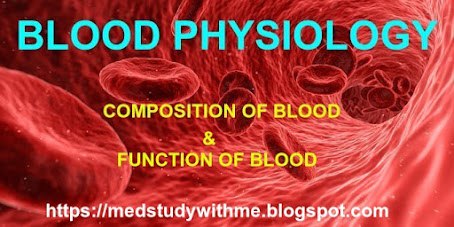BLOOD PHYSIOLOGY
 |
| BLOOD PHYSIOLOGY |
Blood is connective tissue in fluid form.
PROPERTIES
1. Colour
blood is red in colour Arterial scarlet red (contain more oxygen) Venous purple red (contain more Co2)2. Volume
New born - 450 ml Male - 5 litre Female - 4.5 litre
3. p.H
Blood is slightly alkline 7.4 pH4. viscosity
5 times more viscous than water (due to rbc and plasma protein)COMPOSITION OF BLOOD
Blood is formed by blood cells and plasma Blood cells 1. Erythrocyte 2. leukocyte 3. thrombocyte Hematic value Blood is collected in test tube with anticoagulant and centrifused for 30 minutes Result plasma – 55% Rbc – 45%FUNCTION OF BLOOD
1. NUTRITIVE FUNCTION
Nutritive substance like glucose, amino acids, lipids and vitamins derived form food. It is absorbed from gastrointestinal tract. And carried by blood. 2. Respiratory function Transport of gases is done by blood. It carried o2 from alveoli. And co2 from tissue to alveolie. 3. Excretory function Waste product removed by blood. And carried to excretory organ like kidney, skin, liver etc. 4. Transport of hormones and enzyme Hormone is secreted by endocrine gland and release into blood. Blood transport this hormones to their target organ. Blood also transport enzyme. 5. Regulation of water balance Water content of blood is freely interchangable with interstitial fluid This helps in regulation of water in body.IF YOU LIKE THIS ARTICLE THEN PLEASE SHARE WITH YOUR FRIENDS. BECAUSE IT CAN BE HELPFUL FOR OTHERS. AND IT IS TOTALLY FREE.
THANK YOU...


0 Comments
PLEASE DO NOT ENTER ANY SPAM LINK IN THE COMMENT BOX. IF YOU LIKE THIS ARTICLE THEN PLEASE SHARE WITH YOUR FRIENDS. BECAUSE IT CAN BE HELPFUL FOR OTHERS. AND IT IS TOTALLY FREE.